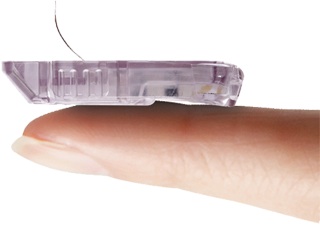Dexcom Seven Continuous Glucose Monitor
December 17, 2011 | 5:03 pmIn our continuous quest to keep a tight control of Samuel’s Type 1 Diabetes, we are going to trial a new device over the next two weeks that will hopefully give us more information about his blood levels.
At the minute, the only way for us to tell whether Samuel is too low or too high is to do a finger prick. If he is low, he can often tell himself, but not often when he is high. And in either case, its almost impossible to predict if he is GOING high or low, so that you can do something about it before it happens. We have been testing 10-15 times a day to try and get as much information as possible, but he still goes low on average once a day and has a really bad high about once a week.
With this is mind, we have bought a Dexcom Seven Continuous Glucose monitor. This new device is not available on the NHS (except for extreme cases – which Samuel is not) so we have had to buy it. It’s not cheap, more of which later.
Here comes the science. It works by inserting another cannula into Samuel (in addition to the one he already has for his pump) which has a sensor on the end of it.
It doesn’t measure his blood glucose but the glucose in the interstitial fluid just under the skin. There is a lag of about 5 minutes between blood blucose levels and the glucose in interstitial fluid. Apparantly, the measurements aren’t as accurate as conventional Bg tests either, around 90% accurate and less so when levels are too high or too low.
The sensor uses a wireless transmitter to send a reading every five minutes to the accompanying handset, which will tell us his level, the direction he is going and present us with a plot of his past few hours.

As I said, it’s not cheap. The starter kit of the sensor, transmitter amd handset costs over £1200. Each sensor lasts 7 days and costs £60.
So why would we be considering this device? It’ll cost over £3000 a year to run and is less accurate than conventional blood testing! Well, the key thing we hope it will show us is trends. It’s important knowing what his Bg is, but it’s just as important to know which direction he is going, be it steady, up or down. This will hopefully allow us to do micro-corrections to try and keep him in range more of the time.
A CGM when connected to an insulin pump are together two thirds of what has become called the ‘Artificial Pancreas’. The other important component is the controling software that constantly analyses the data from the CGM and tells the pump whether to up, lower or suspend insulin doses – all automatically. This is still in the research stages and it will probably be 3-5 years before we see anything on the market.
In the meantime, I’m hoping with the insulin pump and CGM in place, we can become the controlling software and close this loop somewhat ourselves.
We shall see how the first two week trial goes, and I will of course try to update it here.
Posted by Gareth









previous post: Samuel’s quarterly clinic || next post: Dexcom 7 trial